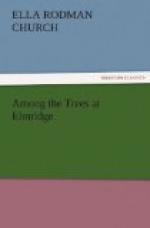“How high do you think these trees are, Miss Harson?” asked Clara. “It makes me dizzy to look up to the top.”
[Illustration: LEAF OF THE CHESTNUT.]
“They can be scarcely less than ninety feet,” was the reply, “and they are very fine specimens of the family; but the great chestnut which is the only tree in the field on the left of the house is broader. It spreads out like an apple tree, because it has abundance of room, and it is nearly as broad as it is high.”
“And aren’t its chestnuts just splendid?” exclaimed Malcolm—“the biggest we find anywhere.”
[Illustration: THE CHESTNUT TREE.]
“The bark, you see,” continued his governess, “is very dark-colored, hard and rugged, with long, deep clefts. In smaller and younger trees it is smooth. I suppose I need not tell you that the fruit is within a burr covered with sharp, stiff bristles which are not handled with impunity. It opens by four valves more than halfway down when ripe, and contains the nuts, from one to three in number, in a downy cup. These green burrs are very ornamental to the tree; and when they are ripe, the green takes on a yellow tinge.”
“You didn’t say anything about the cunning little tails of the nuts, Miss Harson,” said Edith, in a disappointed tone. “I think they’re the prettiest part, and they stick up in the burr like little mice-tails.”
“Well, dear,” was the smiling reply, “you have told us about them, and I think you have given a very good description. That is just what they always reminded me of when I was about your age—little mice-tails.”
Edith looked pleased and shy, and she did not mind Malcolm’s laughing at her “little tails,” because Miss Harson used to think the same as she did about them.
“This beautiful tree came from Asia, and it belongs to the Castanea family, the Greeks having given it that name from a town in Pontus where they obtained it. It was transplanted into the North and West, and is now found in most temperate regions. The wood of the chestnut is very valuable, as it is strong, elastic and durable, and is often used as a substitute for oak and pine. It makes very beautiful furniture.”
“What kind of chestnuts,” asked Clara, “are those great big ones, like horse-chestnuts, that they have in some of the stores? Are they good to eat?”
“Yes,” replied Miss Harson; “they are particularly good, and many people in the southern countries of Europe almost live on them. They are three or four times larger than our nuts, these Spanish and Italian chestnuts, and they are eaten instead of bread and potatoes by the peasantry of Spain and Italy. The Spanish chestnut is one of the most stately of European trees, and sometimes it is found growing in our own country, but never in the woods. It is carefully planted and cultivated as an ornamental tree for private grounds. And now,” added the young lady, “as we have sufficiently examined our American chestnut trees and it is rather damp and cool to-day for tent-life, suppose we return to the house and get better acquainted with the foreign chestnuts?”




